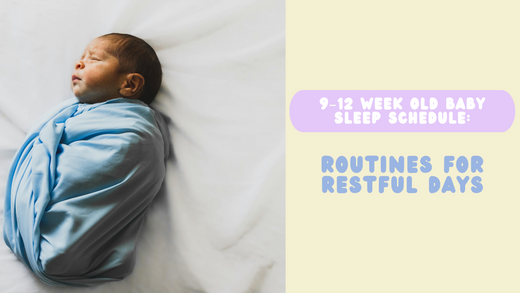
9–12 Week Old Baby Sleep Schedule: Routines for Restful Days
Share
As your baby grows, their sleep patterns start to change, and routines become slightly more predictable. In this guide, we’ll share sample nap routines for 9–12 week olds, offer tips for building healthy sleep foundations, and ensure you have the tools to create an ideal sleep environment. These insights will help you enjoy more flexibility in your day while supporting your baby’s sleep needs.
Why Routines Are Becoming Important
Around 9–12 weeks, babies begin developing more consistent feeding and sleeping patterns. While their circadian rhythm is still maturing, introducing a flexible routine helps create structure without rigidity.
Keep in mind, every baby is unique. If your little one’s sleep needs differ, adjust routines by 15–30 minutes based on their cues. Trust your instincts—you know your baby best!
Nap Routine Tips for 9–12 Week Olds
At this age, your baby’s sleep becomes more organized. A mix of short and long naps supports their development and helps regulate their nighttime sleep. You can choose between a 3-nap or 4-nap schedule based on your baby’s sleep needs.
3-Nap Routine
This sample schedule offers a flexible framework based on typical awake windows and nap durations for this age group:
- 7:00 AM: Awake and milk feed
- 8:30 AM: Nap 1 (short morning nap)
- 10:00 AM: Awake and milk feed
- 11:30–11:45 AM: Nap 2 (long midday nap)
- 2:00–2:15 PM: Awake and milk feed
- 3:30–4:00 PM: Nap 3 (short afternoon nap)
- 5:00 PM: Awake and milk feed
- 5:30–5:45 PM: Bath and wind-down routine
- 6:00 PM: Milk feed
- 6:30–7:00 PM: Asleep in bassinet or crib
4-Nap Routine (Ideal for Catnappers)
This sample schedule offers a flexible framework based on typical awake windows and nap durations for this age group:
- 7:00 AM: Awake and milk feed
- 8:30–9:30 AM: Nap 1
- 10:00 AM: Milk feed
- 11:00–11:45 AM: Nap 2
- 12:45 PM: Top-up milk feed
- 1:15–1:30 PM: Nap 3
- 2:15–2:30 PM: Awake and milk feed
- 4:00 PM: Nap 4 (short evening nap)
- 4:45–5:00 PM: Awake and milk feed
- 5:30–5:45 PM: Bath and wind-down routine
- 6:00 PM: Milk feed
- 6:30–7:00 PM: Asleep in bassinet or crib
💡 Pro Tip: If your baby tends to take short naps, opt for the 4-nap routine instead of trying to extend their nap times. They’ll naturally consolidate naps as they grow.
Sleep Environment Checklist
A calming sleep environment sets the stage for better rest. Here’s a checklist to ensure your baby’s sleep space is just right:
- Dark room: Use blackout curtains to block out light.
- Consistent wind-down routine: Signal that it’s time to sleep.
- Dummy (pacifier): If your baby uses one.
- Sleeping Sack/Swaddle: Choose one suitable for the season. We love a zip and velcro swaddle to reduce the startle reflex. Once your baby is rolling, it is not longer safe to swaddle them.
- White noise: Mimics the womb environment. A favorite is the Hatch Rest Baby Sound Machine.
- Cozy temperature: Keep the room at 68–72°F (20–22°C).
- Full tummy: Feed your baby before naps.
- Pre-sleep kisses and cuddles: A soothing connection before bed.
Overnight Feeding and Settling
Feed your baby on demand overnight. Use hands-on settling techniques, such as rocking or patting, to help them transition back to sleep when needed. This gentle approach builds trust and supports their sleep development.
FAQs for 9–12 Week Old Baby Sleep
1. What if my baby wakes up early from naps?
If your baby wakes early, try to resettle them. If they’re wide awake, adjust their awake windows and monitor sleepy cues to refine the routine.
2. How do I know if my baby needs 3 or 4 naps?
If your baby is taking longer naps (1.5–2 hours), a 3-nap schedule may work best. If their naps are shorter (30–45 minutes), go with the 4-nap schedule. It is also okay to switch between the two routines depending on how each day goes.
3. Should I worry about short naps at this age?
No! Short naps are developmentally normal at this stage. Focus on offering naps consistently and creating a calming sleep environment.
3. How can I tell if my baby is ready for a nap?
Look for common sleepy cues, such as yawning, rubbing their eyes or pulling their ears, red eyes or eyebrows, becoming fussy, or staring off into the distance. When you notice these signals, begin your pre-nap routine to help your baby settle for sleep before they become overtired.
Final Thoughts
At 9–12 weeks, your baby’s sleep is evolving, and routines can help bring more predictability to your days. Whether you choose a 3-nap or 4-nap schedule, the key is flexibility and observing your baby’s cues. Remember, building healthy sleep habits now sets the stage for restful nights and smoother days ahead.
For more expert tips and step-by-step parenting guides, visit Simple Parenting Plans. We’re here to support you every step of the way.
Legal Disclaimer: The information in this blog is for educational purposes only and should not replace professional medical advice. Always consult your pediatrician for specific guidance regarding your child’s sleep. For more information, visit the CDC’s Safe Sleep Guidelines.
As an Amazon Associate, I earn from qualifying purchases. I only link to products that I truly believe in. This means I may earn a small commission when you click on links to Amazon products in this post, at no additional cost to you. Thank you for supporting Simple Parenting Plans!
